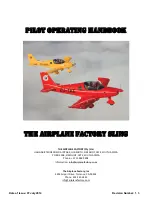
Areas of use
Section 6
29
SWING offers the option of the adjustable
tow adaptor “Pro-Tow”, which facilitates the
tow procedure during launch and pre-
accelerates the canopy during this stage by
about 2cm.
PLEASE NOTE
SWING recommends that pilots use an
appropriate tow adaptor, which gives
greater safety margins during towing.
Tandem paragliding
The APUS RS does not have certification for
use in tandem paragliding.
Aerobatics
In Germany, it is prohibited to perform
aerobatics using a paraglider, which under
German law is included under the term
“aerial sports equipment” -
Luftsportgerät
.
Aerobatics is defined as flight manoeuvres
at an angle greater than 135° along the
longitudinal (roll) axis or lateral (pitch) axis.
The APUS RS was not developed or tested
for aerobatic use.
Motorised flight
In Germany, use of paragliders for motorised
flight requires additional certification.
Please check the situation in your country.
If you would like to use the APUS RS with a
motor,
please
contact
SWING,
the
manufacturer of the motor or a testing centre
approved by the LBA (German Federal
Aviation Office). Their addresses are in the
Appendix.
WARNING
If you are using a front-mounted reserve
system, it is important to ensure before
first launch that it can be deployed without
any obstruction. If this is not the case,
then only a webbing release system
should be used.
WARNING
If a webbing release system is used,
there is an increased risk of lockout. This
means that the glider does not fly towards
the winch and control pressure by the
pilot is not sufficient to correct this. You
should therefore check regularly the
position and alignment of the glider to the
pilot during towing, as the towing rope
hangpoint located well in front of the pilot
encourages the glider to turn, and this
may not be detected.
WARNUNG
When using rigid tow releases, the
release/shackle
distance
should
be
extended sufficiently (cord or webbing
strap) and the release must be secured
with a retaining cord so that it does not fly
back (in the event of towline failure).
When
using
the
release
system
attachment, ensure that the distance
between the risers is not reduced (risk of
twist).
WARNING
Any type of acrobatic manoeuvre at all on
the APUS RS is contrary to law and
illegal. The pilot would be putting his/her
life at risk. Acrobatics involves a risk of
unpredictable flight attitudes, which could
lead to damage to material and structural
failure.
















































